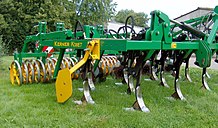Heavy cultivator
The heavy cultivator emerged as a further development of the conventional cultivator in the middle of the 20th century with the aim of being able to carry out non-turning soil cultivation even in deeper layers of plowless arable farming . It is used instead of the plow or as a supplement.
The aim of cultivating the soil with a heavy cultivator is to loosen the soil and mix in crop residues or fertilizer in order to achieve faster rotting . Depending on the main application, different types are used. What the different versions have in common is the heavy construction compared to other cultivators .
Heavy cultivators are usually offered with two to four rows of cultivator tines, the so-called bars, arranged on a stable metal frame. The tines are arranged at a fixed distance one behind the other on the individual bars that are perpendicular to the direction of travel so that the soil is worked evenly. Depending on the number of rows of tines, z. B. spoken of a three-row cultivator for a three-row device.
As a rule, heavy cultivators with rear runners are used, which achieve leveling, recompaction or crumbling. At the same time, they usually serve as a depth guide.
Parameters
- The line spacing describes the ratio of the working width to the number of tines. The smaller this distance, the more intensive the loosening and mixing of the soil.
- The tine passage corresponds to the distance between tines lying next to one another on adjacent bars. The tine passage is greater, the more beams a heavy cultivator has.
- The working depth is usually 10–15 cm, rarely up to 20 cm.
advantages
Due to its burrowing properties, the heavy cultivator works harvest residues superficially into the active soil layer, which accelerates the rotting process and increases soil fertility . It protects the soil life, especially the earthworms . In the context of conservation tillage, it significantly reduces the erosion of endangered arable land.
disadvantage
Since a working width of at least one tractor width is desired, the pulling force required is relatively high in order to achieve the necessary speeds of approx. 6-8 km / h. In krumentiefer processing per meter working width will be approximately 25 kW tractor driving power needed.
If there is insufficient tine passage and high crop residues, the heavy cultivator tends to clog.
Since a larger percentage of crop residues remain on the surface compared to plowing, the spread of diseases in the subsequent crops can lead to significant yield losses.
Share shapes
Depending on the tillage and type of construction, different share shapes are attached to the tines. The double heart group is considered a universal group and takes its name from the heart-shaped widening at both ends. It achieves a very good loosening and mixing effect. If necessary, it can be rotated 180 °, which significantly increases the service life. A special share is the wing share, a pointed share with additional wings on both sides. Above all, it has a relaxing effect. The goosefoot flock represents something in between the two first-mentioned flocks. Their advantage lies in the greater possible line spacing compared to the heart flock with still acceptable mixing.
Tine shapes
With heavy cultivators, a distinction is made between different tine shapes. The rigid tine allows precise depth and lateral guidance even at high working speeds. Shear bolts secure it against overload. With the semi-rigid tine shape, a pressure spring protects against overload, and with newer models also a hydraulic system, which allows the tines to be deflected upwards if necessary. The fully sprung form is available as spiral spring or leaf spring tines. Since these tines can deviate both vertically and horizontally, they have a more uneven tillage in relation to the other shapes. As a special form, the chisel is to be mentioned, which is strongly set to grip, i.e. the share is strongly in the direction of pull. He loosens the soil.
Types
Peeled cultivator
The most frequently used device is usually offered in a 3 to 4-bar frame. The rigid and semi-rigid types are the main types of prongs. The double heart share is most often installed. The cultivator is mainly used for stubble cultivation , because its narrow line spacing of 20 to 25 cm causes intensive loosening and mixing of the soil.
Short cultivator
The wing share cultivator, which usually has one to two beams, is often used with heavy rear rollers (cutting ring roller, cracker roller) as they have to crush and reconsolidate the roughly torn clods of earth. The cultivator only breaks up the soil. The tine spacing is up to 50 cm, depending on the wing share. It is mostly used in the same way as the plow, as it is a good way to make the volunteer grain emerge. The short cultivator cannot guarantee a good mix of plant residues and soil because the line spacing is very large. The ease of movement of the device should be emphasized as there are only a few blades in engagement.
Plow cultivator
This special shape, equipped with chisel shares, is used to break up heavy soils. Since loosening is in the foreground, a follower is usually not used.
More types
The distinction to surface finishing devices is not always possible. In some cases, rotary harrows with the tines set to grip are called rotary cultivators. Fine cultivators with spring tines, which are otherwise used in secondary tillage, are sometimes used for stubble cultivation on light soils.
Individual evidence
- ↑ Horst Eichhorn, Landtechnik, 7th edition, Ulmer, Stuttgart, 1952, 1999, ISBN 3-8001-1086-5 , p. 164.
literature
- Agriculture: Volume 3 - Agricultural engineering and construction . BLV Verlagsgesellschaft, Munich, ISBN 3-405-14349-7






